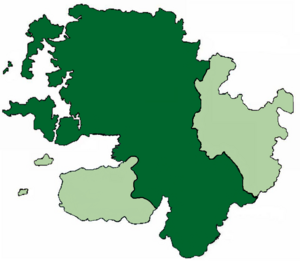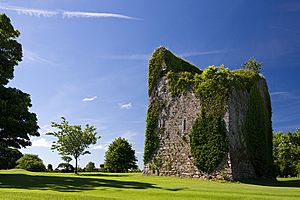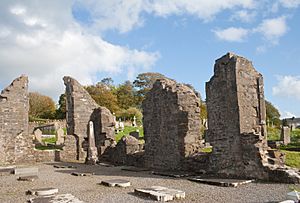Tibbot MacWalter Kittagh Bourke facts for kids
Quick facts for kids Tibbot MacWalter Kittagh Bourke(Tiobóid mac Walter Ciotach Búrca) |
|
|---|---|
| 21st Chief of Mac William Íochtar | |
| Reign | 1595–1602 (disputed reign) |
| Predecessor | William An tAb Caoch Bourke |
| Successor | Richard Bourke (d. 1601) Title Abolished |
| Born | c. 1570 Ardnaree, County Mayo, Ireland |
| Died | In or after 1602 Most likely Spain |
| Consort | identity unknown |
| Issue | Walter Bourke Meyler Bourke (d. 1595) John Burke (?) |
| House | Mac William Íochtar |
| Father | Walter Kittagh Bourke |
| Mother | Mary O'Donnell |
| Religion | Roman Catholic |
Tibbot MacWalter Kittagh Bourke (also known as Theobald Fitzwalter) was an important Irish leader. He was the 21st and last "Mac William Íochtar," a title for a powerful chief in County Mayo, Ireland. He became chief in 1595 during a big war called the Nine Years' War. This war was fought between Irish lords and the English government.
Tibbot MacWalter Kittagh was chosen by Hugh Roe O'Donnell, a strong Irish rebel leader. But many other local leaders, especially his rival Tibbot na Long Bourke, did not agree with this choice. The two Tibbots fought for control of Mayo throughout the war. In 1602, Tibbot MacWalter Kittagh went to Spain, and the title of Mac William Íochtar was ended forever.
Contents
Family and Early Life
Tibbot MacWalter Kittagh was born around 1570 in Ardnaree, near Ballina, in County Mayo. His father was Walter Kittagh Bourke, who was a sheriff. His mother was Mary O'Donnell. Tibbot had four brothers and four sisters.
We don't know much about Tibbot's wife, but he had at least two sons, Walter and Meyler. It's also thought that John Burke, a military leader later on, might have been his son too.
Arrest and Escape
Tibbot's father had been part of a rebellion against English rule in the 1580s. After his father died, young Tibbot was targeted by his uncles. In 1593, the English government offered pardons to people in Mayo, but Tibbot was left out.
He tried to get a pardon, but he was arrested in Athlone. While he was in prison, it's said that his wife secretly gave him a tool. This helped him and other prisoners escape on September 28. After his escape, Tibbot fled to Tyrconnell to find safety with Hugh Roe O'Donnell, who became his friend and ally. Because he escaped, his castles in Cloonagashel, Castlebar, and Belleek were taken by the English.
The Nine Years' War
Rebellion and Return

From 1593 to 1595, many Irish nobles in Connacht supported the rebel leaders O'Donnell and O'Neill. They didn't like the English presence. By 1595, most of Connacht was in rebellion.
Tibbot MacWalter Kittagh returned to Mayo in August 1595. He tried to take back Belleek castle, which used to be his. The English sent soldiers to help the castle, but they were defeated. The castle was soon surrendered to Tibbot.
Becoming Chief

Many clans in Mayo wanted to bring back the old MacWilliam chieftainship. O'Donnell worked for months to convince nobles to hold a traditional ceremony. On December 24, 1595, they met at Kilmaine. Many important families were there. Nine different Bourke leaders wanted the title, including Tibbot MacWalter Kittagh and Tibbot na Long Bourke.
However, O'Donnell had already decided who would be chief. He arrived with 1,800 soldiers, showing his power. He called in each noble to hear their choice, but he ignored their advice. Most nobles wanted William Bourke, an older and more experienced leader. Tibbot MacWalter Kittagh was the youngest and least popular.
Despite this, O'Donnell publicly announced Tibbot MacWalter Kittagh as the new MacWilliam chief. He had an elder of the Bourke clan perform the ceremony. O'Donnell's decision made many Connacht leaders angry. They felt insulted because he asked for their opinion but then ignored it.
Attacks on Galway
Soon after becoming chief, Tibbot MacWalter Kittagh and O'Donnell attacked the town of Athenry. They burned it down and took prisoners. Then they went to Galway city and demanded supplies. The city refused to open its gates.
On January 17, 1596, Tibbot and O'Donnell launched a surprise attack on Galway. They burned houses outside the city and killed people. These attacks made many local lords and merchants in Galway turn against the rebels.
Losing Control of Mayo

In June 1597, Tibbot MacWalter Kittagh and Rory O'Donnell (Hugh's brother) were in control of Mayo. But a new English governor, Conyers Clifford, tried to take back control. Clifford sent Tibbot na Long Bourke and O’Conor Sligo to fight the rebels.
Tibbot MacWalter Kittagh and Rory tried to escape to Ulster through the Ox Mountains. But they were caught and defeated by Clifford's forces, losing many men and cattle.
Later that year, Tibbot MacWalter Kittagh returned to Mayo. But the war had caused a famine, making it hard to keep soldiers. Tibbot na Long launched a surprise attack, defeating Tibbot MacWalter Kittagh's forces and forcing him to retreat to Ulster again. By late 1597, Tibbot MacWalter Kittagh was in exile, and his supporters in Mayo had asked the English for protection.
A Second Chance

In 1598, a truce was signed. O'Neill, the main Irish rebel leader, demanded that Tibbot MacWalter Kittagh be given control of Mayo. But Queen Elizabeth I refused.
After a big Irish victory at the Battle of the Yellow Ford in August 1598, O'Donnell and Tibbot MacWalter Kittagh returned to Mayo. The English forces were weak. The McDonagh family betrayed the English and gave Ballymote Castle to O'Donnell.
Tibbot MacWalter Kittagh re-established himself in Mayo with a large army. Tibbot na Long Bourke, his rival, had to use his ships to escape by sea. Tibbot MacWalter Kittagh and his allies raided Mayo, crushing anyone who opposed them.
The War Continues
For many months, the English struggled to regain control. In July 1599, Governor Clifford was given money to rebuild Sligo castle. Tibbot na Long sailed with supplies to Sligo Bay to meet Clifford.
However, Clifford was ambushed and killed at Curlew Pass. This was a huge defeat for the English. Tibbot na Long, still at sea, refused to join the rebels and sailed back to Galway.
The war spread across Ireland. Tibbot MacWalter Kittagh's importance in the larger war became smaller. O'Donnell tried to make peace in Mayo between the two Tibbots.
A Secret Plan

In December 1599, O'Donnell arranged a truce between the two Tibbots. Tibbot MacWalter Kittagh's power was limited to his own area, Tirawley, in exchange for peace in Mayo.
By 1600, the English were gaining ground in Ireland. They used a "scorched earth" tactic, burning crops, which caused widespread famine. The English also tried to get Irish lords to switch sides.
Tibbot MacWalter Kittagh began talking with the English. He hoped to gain security for his lands by changing his loyalty. O'Donnell had made him chief, but he had also taken many resources from Mayo, leaving it weak.
In June 1600, Tibbot MacWalter Kittagh met with a man named James Blake to discuss a secret plan. The plan was to lure O'Donnell to Donegal Abbey and capture or remove him. They also hoped to capture O'Neill. Tibbot MacWalter Kittagh planned to bring 400 men to Donegal and take Killybegs castle.
He asked the English for a title (Earl of Mayo), to be the Queen's leader in the county, and to receive money. The Queen agreed to most of his demands in December 1600, but she said he would get the money *after* he carried out the plan. Without the money upfront, Tibbot MacWalter Kittagh couldn't buy the castle. The plan was dropped when Captain Thomas Lee, who was involved, was executed for treason in 1601.
Last Months and Departure to Spain
In early 1601, the peace in Mayo broke down. Tibbot na Long attacked Tibbot MacWalter Kittagh, forcing him to flee to Ulster again. Tibbot na Long then gathered other nobles, and they chose Richard "the Devils Hook" Bourke, Tibbot na Long's brother-in-law, as the new MacWilliam Íochtar.
In October 1601, Tibbot MacWalter Kittagh returned to Mayo with soldiers from O'Donnell. He fought Richard Bourke, who was killed in the battle. Tibbot MacWalter Kittagh once again declared himself chief of Mayo.
With his rivals defeated, Tibbot MacWalter Kittagh joined O'Donnell at the Battle of Kinsale in late 1601. After the Irish forces lost at Kinsale, Tibbot MacWalter Kittagh traveled with O'Donnell to Spain. He landed in Luarca on January 13, 1602. He never returned to Ireland. The King of Spain, Philip III, gave him the title of Marquess of Mayo and a pension.
His son, Walter, later became the 2nd Marquess of Mayo.
See also
- Clanricarde
- Burke Civil War 1333–38
- Ireland 1536–1691
- Surrender and regrant
Images for kids




